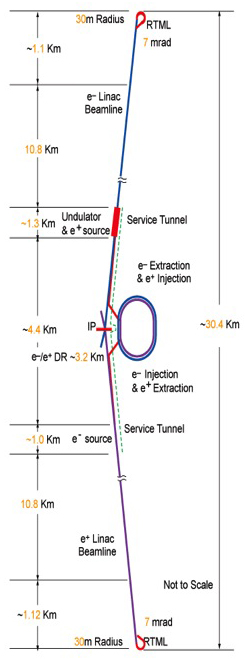How long is the ILC linear accelerator? This simple question does not have a simple answer.
In the first place, the electron linear accelerator, or linac, is longer than the positron linac because it’s the electron beam’s responsibility to produce the positrons, so part of the electron linac’s length is dedicated to that task. The electron beam passes through an undulator, a device that causes the beam to wiggle left and right like a snake, producing an intense beam of gamma rays. These rays strike a target and, after capture, selection and acceleration, produce a beam of positrons. The positrons are then injected into the damping ring. In producing the gamma ray beam the electrons lose gigaelectronvolts (GeV) of energy, which requires on the order of 100 metres of additional accelerator to replace. In addition, the undulator, target and capture systems occupy several hundred metres more tunnel length in line with the linac.
Another impact of this positron production system affects the length of the other linac, the positron linac, which is located opposite the electron linac on the other side of the interaction region, and its tunnel. After the electron beam has gone through the undulator system, it bypasses the positron capture systems and goes through the final focus system to the interaction point. Here it collides with the positron beam, which was produced by the previous cycle of electrons one fifth of a second earlier and which has gone around the damping ring a million times before being extracted, transported to the beginning of the positron linac and accelerated through to the interaction region. The electron and positron bunches must arrive at the interaction point at the same time with picosecond accuracy. That means that the difference in the distance travelled by the electron and positron bunches starting at the positron target and terminating at the interaction region must be exactly equal to N (an integer) times the circumference of the damping ring to millimetre accuracy. This cannot be achieved without careful layout of the geometry of several systems and tunnels and with some degree of adjustability after construction. This path length adjustment can be done with path length-changing chicanes or with manipulation of the beams in the damping rings during the interpulse period. It is very desirable to minimise the size and complexity of these post-construction adjustments, and because the length of the positron linac (or more correctly, the length of the tunnel containing it and the ring to linac system) is a major component of this path length, we have constraints on its length.
In the recent Baseline Technical Review at KEK, we discussed the linac length issue at great length as there are many technical choices that can affect it. In addition there is a natural desire to have some safety factor, or some extra length of tunnel and accelerator, say a few hundred metres, to guarantee the linac can reach full design energy, roughly 500 GeV, under conservative performance assumptions. As one can conclude from the above, it is not difficult to add length to the electron linac at the extra cost of the tunnel and facilities. However, on the positron linac side things are much more complex because of the timing issue and its path length corrections. An agreement on a design length was reached pending a final check on the lengths of all the components and systems.
So, to the question, How long are the ILC linear accelerators?, we give this answer: they will be just long enough, roughly 11 kilometres each.




Recent Comments